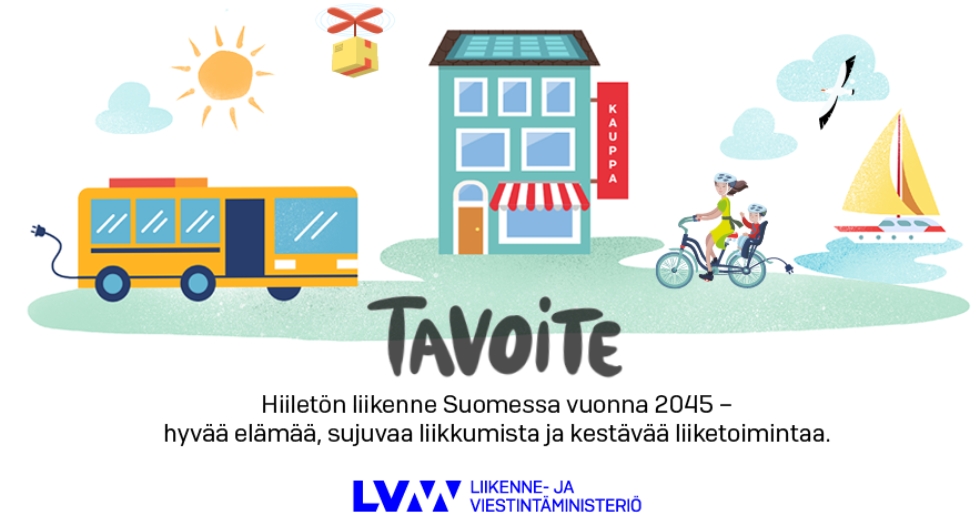Carbon-free transport by 2045 – Paths to an emission-free future

The Ministry of Transport and Communications' Transport Climate Policy working group has compiled three alternative scenarios with the aim of eliminating transport emissions. In its interim report, the working group notes that there is no one simple solution.
Combating climate change is one of the key challenges facing humankind now and in a near future. Eliminating greenhouse gas emissions from transport is an important part of the solution, as in countries like Finland, about one fifth of these emissions come from transport. The target set in the Government's Medium-term climate change policy plan is that Finland should be carbon neutral by 2045.
"If we intend to halt the global catastrophic consequences of climate change for our society, it is essential that actions resulting in major emission reductions are launched right now. We must also be prepared to make decisions that seem difficult", says Director-General Juhapekka Ristola, who chairs the working group.
The purpose of the SERVICE, BIO and TECHNO scenarios produced by the Transport Climate Policy working group is to highlight the impacts of various factors on transport emission volumes and outline different packages of measures associated with each path. The scenarios are intended as thinking tools, and the working group does not propose that they be implemented as such.
The interim report by the Transport Climate Policy working group was published on 14 September 2018. An actual practicable proposal for an action plan and the proposal's impact assessments will be presented in the group's final report in December 2018. The working group includes representatives from key ministries and universities as well as companies.
From scenarios to selection of actions
The working group has produced three distinctive scenarios, or transition paths, which highlight the impacts of different factors on emission volumes. The scenarios also describe the means required to achieve the targets. The alternatives are presented as extreme scenarios.
Rather than a proposal for actions to be implemented, the transition paths are a list of measures that would lead us towards the different future scenarios. The idea is that by making wise selections among these measures, we can reduce and ultimately eliminate greenhouse gas emissions from transport.
The BIO path would aim to reduce emissions by phasing out fossil fuels and adopting renewable fuels and fuels with lower emissions. If the BIO path were chosen, the availability and price of sustainably produced biofuels as well as their impacts on the carbon sink proved to be problem points. In the transport sector, a need to transition to biofuels affects not only road transport but also air traffic and shipping, which pushes up the demand.
The TECHNO path would reduce emissions by utilising the technological development of vehicles, for example by transitioning to the use of electric cars. Sufficiently fast renewal of the entire stock of cars and other vehicles in order to reduce emissions would prove challenging with the TECHNO path. In the fields of shipping and air traffic, the situation is similar or even more challenging.
The SERVICE path would reduce emissions primarily by reducing the transport performance (kilometres driven) and improving the energy efficiency of the transport system in other ways. It would lead to a world where shared transport and Mobility as a Service (MaaS) play a key role. MaaS provides a carefree, environmentally sound alternative to owning a car. The remaining transport performance and the greenhouse gas emissions related to it would prove challenging, were the SERVICE path chosen.
As complementary means of eliminating greenhouse gas emissions from transport are examined the possibility of using offset credits in Finland, at the EU level or internationally.
While the transition paths have been described as separate choices, they have many things in common. They all share the same goal: eliminating greenhouse gas emissions from transport by 2045. The precondition for achieving the goal on all paths is a strong political will to implement the actions.
What next?
The working group will continue its efforts by surveying the stakeholders' and citizens' views and through active dialogue. The survey will be open until 8 October 2018. Dialogue will take place at separately organised discussion events and on the social media.
The working group will draft a practicable proposal for an action plan during the autumn.
In the final report, the group will lay the foundation for societal decision-making by summarising the means by which domestic traffic can be made carbon neutral by 2045. It will also consider whether or not carbon neutrality could be reached even sooner than this.
Further information:
Vice chair of the working group, Director Sabina Lindström, Ministry of Transport and Communications, tel. +358 40 527 6103, [email protected], Twitter @LindstromSabina
Secretary of the working group, Ministerial Adviser Johanna Särkijärvi, Ministry of Transport and Communications, tel. +358 295 34 2024, [email protected], Twitter @josalvm
Leader of the BIO path, Director General Juhani Damski, Finnish Meteorological Institute, tel. +358 295 392 201, [email protected], Twitter @JuhaniDamski
Leader of the SERVICE path, Division Director Mirja Noukka, Finnish Transport Agency, tel. +358 295 343 024, [email protected], Twitter @MNoukka
Leader of the TECHNO path, Director General Mia Nykopp, Finnish Transport Safety Agency Trafi, tel. +358 295 345 200, [email protected], Twitter @MiaNykopp
The other working group members may also be contacted for further information. For their contact details, see the list attached to this press release.



